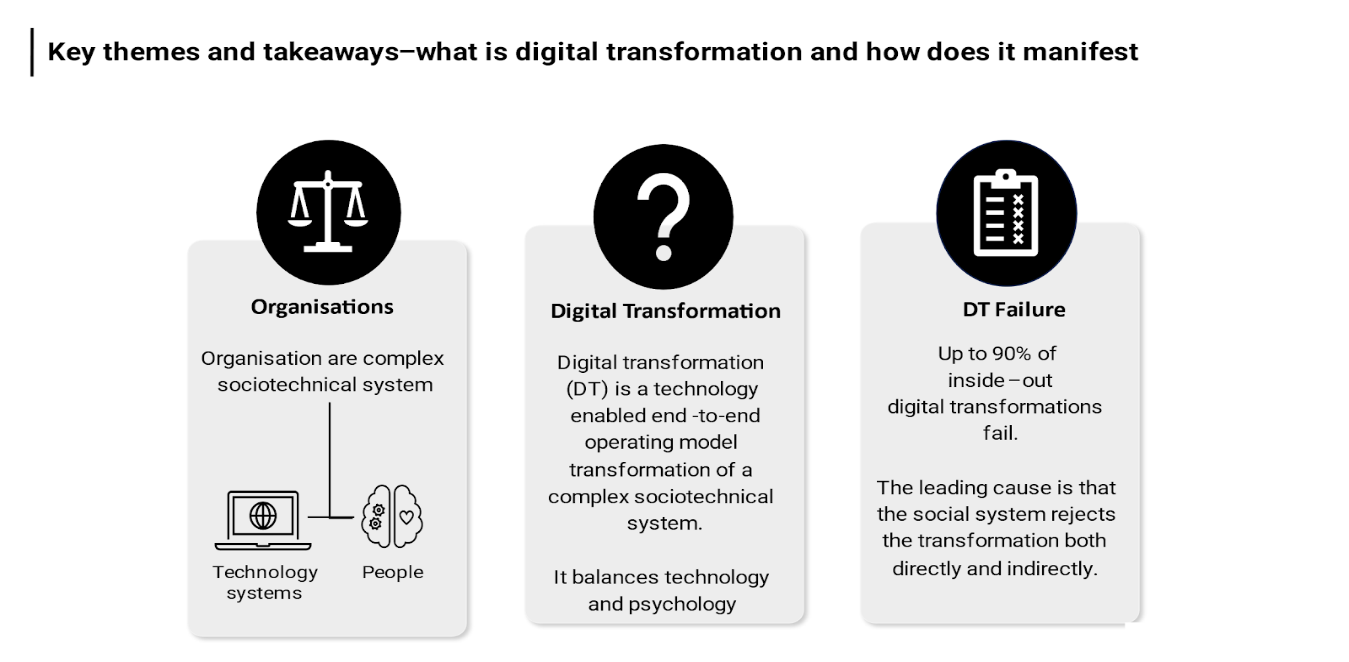Essentially, failure ensues when organizational leaders try to put lipstick on pigs…
Why do digital transformation (DX) projects fall? The reason is that the term “digital transformation” is an optical illusion. The shiny word ‘digital’ distracts from the real meaning — and requirement — which is organizational transformation.
This illusion has led to the misconception that technology is the leading cause of such failures.
The even bigger misconception is that DX is about technology in the first instance. Most companies embarking on digital transformation consider these to be tech projects to be handled by their CIO, thereby ending up, to put it bluntly, putting (digital) lipstick on a pig.
In fact, DX is about fundamentally reworking an organization — which are complex social and technical systems that involve not only processes and technologies but, most importantly, people.
Correcting the misconceptions
The first step is to realize that we are in the middle of another technological revolution, often termed the fourth industrial revolution. The need for organizations to respond is, therefore, not optional but an existential necessity.
Second, true DX is not based on incremental change to the status quo. DX is about redefining the organization to survive what is an unstoppable paradigm shift. Transformation is not change, and digitally enabled organizational transformation requires a new way of thinking.
Corporate history abounds with companies that were so focused on details and making incremental improvements to existing products that they failed to understand that their sector was going through such a paradigm shift: Kodak failed to anticipate digital cameras and the end of physical film; Nokia and Blackberry had fantastic devices but the iPhone changed the entire purpose of a mobile phone.
Innovation and discontinuation will likely be more successful by returning to a clean sheet and looking at solving the existing (old or established) problem but in a radically new way, enabled by a new set of technological and operational tools and a new perspective.
This makes it clear that adopting new technologies such as AI to improve a company’s current operations incrementally will not work. Businesses may not have to literally rewire the walls, but they must rewire organizational thinking inside-out. A good example is Netflix.
The third reason many DX projects fail is that they did not take sufficient account of the human element: in other words, the people working there. More often than not, senior leadership believed it was undertaking a technology project when, in reality, it was trying to transform the company’s strategy, operating models and, most notably, the individual mindsets within the internal social collective.

Achieving DX success
Like any complex system, the organization will defend itself against what it perceives as an attack. All legacy systems would have accumulated not just financial costs but technical, process and organizational debt: established ways of working and working around existing realities. Transformation threatens these enshrined values and mindsets.
So, because corporations consist of human beings, the first question to be asked will not be “how does this help the company?” but “how does this impact me?”
Supply an emotionally-tinged answer and the result is widespread grassroots resistance. The social system does not reject the actual digital technology — that is merely an enabler for the mooted transformation; it rejects the transformation itself since it threatens the status quo’s institutional logic.

So, how can companies transform successfully? At the outset, it is critical to grasp both the size of the issue (the digital revolution is an inevitable paradigm shift) and the scale of the internal challenge (a fundamental need to overhaul the entire organization) and to keep doing so.
Take Amazon as a good example: through the agile evolution of its business over the past 30 years, its strategy of repeatedly disrupting itself and of investing heavily ahead of profitability to build mindshare have remained constant. Having weathered early brushes with bankruptcy, this approach has been paying off handsomely.
Next: once the need for wholesale and continuous transformation is understood, proceed by balancing technology with psychology. Spend more time on winning over your employees, partners and other stakeholders than on designing software architecture and ordering new kit. Achieving internal consensus, or as close to this as possible, before forging ahead is vital.
Above all, make this a Board-level issue led by the CEO and the entire senior management team, or else the staff in the rest of the organization will sense a lack of commitment. After all, a true transformation will touch every aspect of your business as you rework your operating model from end to end.
None of this is easy. But those companies that manage it will ensure their survival and, indeed, their growth and prosperity in a new era. And that, surely, is staking a claim to corporate immortality.
